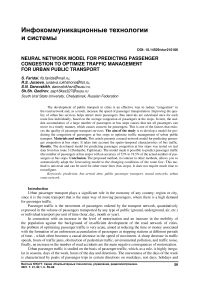Neural network model for predicting passenger congestion to optimize traffic management for urban public transport
Автор: Faridai S., Juraeva R.S., Darovskikh S.N., Qodirov Sh.sh.
Рубрика: Инфокоммуникационные технологии и системы
Статья в выпуске: 1 т.21, 2021 года.
Бесплатный доступ
The development of public transport in cities is an effective way to reduce “congestion” in the road network and, as a result, increase the speed of passenger transportation. Improving the quality of urban bus services helps attract more passengers. Bus intervals are calculated once for each route line individually, based on the average congestion of passengers at the stops. In turn, the sudden accumulation of a large number of passengers at bus stops causes that not all passengers can move in a timely manner, which causes concern for passengers. This is one of the factors that reduces the quality of passenger transport services. The aim of the study is to develop a model for predicting the congestion of passengers at bus stops to optimize traffic management of urban public transport. Materials and methods. This article presents a neural network model for predicting passenger congestion at bus stops. It takes into account the spatio-temporal characteristics of bus traffic. Results. The developed model for predicting passenger congestion at bus stops was tested on real data from bus route 3 (Dushanbe, Tajikistan). The model made it possible to predict passenger traffic (the number of passengers at bus stops) with an accuracy of 72% to 74.5% of the actual number of passengers at bus stops. Conclusion. The proposed method, in contrast to other methods, allows you to automatically adapt the forecasting model to the changing conditions of the route line. This method is universal and can be used for other route lines (bus stops). It does not require much time to reconfigure.
Prediction, bus arrival time, public passenger transport, neural networks, urban route network
Короткий адрес: https://sciup.org/147233801
IDR: 147233801 | УДК: 519.254 | DOI: 10.14529/ctcr210106
Список литературы Neural network model for predicting passenger congestion to optimize traffic management for urban public transport
- Turevsky I.S. Avtomobil'nyye perevozki: ucheb. posobiye [Automobile transportation: a tutorial]. Moscow: Forum, INFRA-M, 2016. 222 p.
- Xue R., Sun D., Chen Sh. Short-Term Bus Passenger Demand Prediction Based on Time Series Model and Interactive Multiple Model Approach. Discrete Dynamics in Nature and Society, vol. 2015, article ID 682390, 11 p.
- Blom H.A.P. An efficient filter for abruptly changing systems. Proceedings of the 23rd IEEE Conference on Decision and Control, 1984, pp. 656-658.
- Averbuch A., Itzikowitz S., Kapon T. Radar target tracking- viterbi versus IMM. IEEE Transactions on Aerospace and Electronic Systems, 1991, vol. 27, no. 3, pp. 550-563.
- Zhang Y., Liu Y. Traffic Forecasts Using Interacting Multiple Model Algorithm. Chien B.C., Hong T.P., Chen S.M., Ali M. (eds.) Next-Generation Applied Intelligence. IEA/AIE 2009. Lecture Notes in Computer Science, vol. 5579. Springer, Berlin, Heidelberg, 2009, pp. 360-368 DOI: 10.1007/978-3-642-02568-6_37
- Ma Z., Xing J., Mesbah M., Ferreira L. Predicting shortterm bus passenger demand using a pattern hybrid approach. Transportation Research Part C: Emerging Technologies, 2014, vol. 39, pp.148-163.
- Liu G., Yin Z.Z., Jia Y., Xie Y. Passenger flow estimation based on convolutional neural network in public transportation system. Knowl.-BasedSyst., 2017, vol. 123, pp. 102-115.
- Gao C., Li P., Zhang Y., Liu J., Wang L. People counting based on head detection combining Adaboost and CNN in crowded surveillance environment. Neurocomputing, 2016, vol. 208, pp. 108-116.
- Wang Z., Cai G., Zheng C., Fang C. Bus-crowdedness estimation by shallow convolutional neural network. Proceedings of the International Conference on Sensor Networks and Signal Processing (SNSP), Xi'an, China, 28-31 October 2018, 20 p.
- Hamblen M. The digital revolution at the cost of privacy. Computerworld Russia Magazine, # 04/2017, iss. 4-2017, pp. 26-27.
- Qodirov Sh.Sh., Shestakov A.L. Development of Artificial Neural Network for Predicting Drill Pipe Sticking. Bulletin of the South Ural State University. Ser. Computer Technologies, Automatic Control, Radio Electronics, 2019, vol. 19, no. 3, pp. 20-32. (in Russ.) DOI: 10.14529/ctcr190302
- Chollet F. Deep Learning with Python: Manual. Manning Publications, 2017. 386 p.
- Gulli A., Pal S. Deep Learning with Keras: Hand Book. Birmingham - Mumbai, Packt, 2017. 310 p.
- Haykin S. Neyronnye seti: polnyy kurs [Neural Networks: A Comprehensive Foundation]. Moscow, Williams Publ., 2006. 1104 p.
- Raschka S. Python Machine Learning. Birmingham, Packt Publishing, 2015. 454 p.
- Grus J. Data Science from Scratch: First Principles with Python. O'Reilly Media, 2015. 330 p.
- Jojo M. Learn Keras for Deep Neural Networks: Hand Book. Canada, Apress, 2019. 192 p.
- Ketkar N. Deep Learning with Python: A Hands-on Introduction. India, Apress, 2017. 162 p. DOI: 10.1007/978-1-4842-2766-4
- Wani M.A., Bhat F.A., Afzal S., Khan A.I. Advances in Deep Learning. Studies in Big Data book series (SBD, volume 57). Springer Singapore, 2020. 159 p. DOI: 10.1007 / 978-981-13-6794-6
- McMahan B., Rao D. Znakomstvo s PyTorch: glubokoye obucheniye pri obrabotke estestvennogo yazyka [Introducing PyTorch: Deep Learning in Natural Language Processing]. St. Petersburg, Peter, 2020. 256 p.
- Melin P. Modular Neural Networks and Type-2 Fuzzy Systems for Pattern Recognition. Studies in Computational Intelligence book series (SCI, volume 389). Springer-Verlag Berlin Heidelberg, 2012. 215 p. DOI: 10.1007 / 978-3-642-24139-0
- Melin P., Castillo O., Kacprzyk J. Design of Intelligent Systems Based on Fuzzy Logic, Neural Networks and Nature-Inspired Optimization. Studies in Computational Intelligence, volume 601. Springer International Publishing Switzerland, 2015. 612 p. DOI: 10.1007 / 978-3-319-17747-2_14
- Kyriakides G., Konstantinos G.M. Hands-On Ensemble Learning with Python: Build highly optimized ensemble machine learning models using scikit-learn and Keras. Birmingham - Mumbai, Packt Publishing, 2019. 298 p.
- www.citycard.tj.


